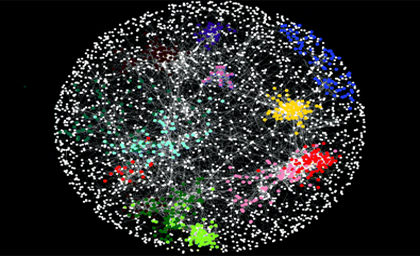新方法:可绘制全基因组水平的基因互作图谱
| 导读 |
后基因组时代面临的一个巨大挑战是,在正常和疾病状态下,理解人类基因共同发挥作用的机制。现在,加州大学旧金山分校UCSF的研究人员开发了一个新方法,能够在不同细胞中一次性解析数千种基因的相互作用。文章发表在本周的美国国家科学院院刊PNAS杂志上。
为了展示这一方法的有效性,研究人员用蓖麻毒素处理细胞,然后分析基因互作发生的改变。蓖麻毒素(ric... |

后基因组时代面临的一个巨大挑战是,在正常和疾病状态下,理解人类基因共同发挥作用的机制。现在,加州大学旧金山分校UCSF的研究人员开发了一个新方法,能够在不同细胞中一次性解析数千种基因的相互作用。文章发表在本周的美国国家科学院院刊PNAS杂志上。
为了展示这一方法的有效性,研究人员用蓖麻毒素处理细胞,然后分析基因互作发生的改变。蓖麻毒素(ricin)的合成相对简单,这种毒素会关闭细胞内的蛋白合成,从而产生致命的影响。不过,人们还不清楚蓖麻毒素靶标的确切基因。
在微生物领域,高密度的基因互作图谱是阐明基因功能和相关通路的有力工具。而加州大学Jonathan Weissman实验室的研究人员,针对哺乳动物细胞开发了一整套方案。该方案以混合shRNA筛查为基础,能够在全基因组水平上鉴定表型相关基因,并对这些基因进行系统性作图,最终得到完整的基因互作图谱。
“这种方法很适合为癌症等疾病寻找潜在药物,也能帮助人们进一步理解基因组的复杂性,”文章的第一作者,加州大学的博后Martin Kampmann说。
Kampmann及其同事的这一新方案,可以通过混合实验,一次性检测不同实验条件下的不同细胞,从中筛查基因的相互作用情况。他们对经蓖麻毒素处理的细胞进行了分析,鉴定了一些未知功能的基因,并通过基因互作模式,确定了这些基因的功能。“它们与已知功能的一些基因,有相似的互作模式,”文章的共同作者,博后Michael Bassik说。
研究人员对暴露在蓖麻毒素中的细胞进行了全基因组筛选,通过复杂的shRNA文库来检测目标基因。他们利用测序监测细胞中各shRNA的表达情况,以此确定对细胞敏感性有影响的基因。
随后,研究人员对选定的shRNA进行克隆和编码,构建了有针对性的文库,重新检验相关表型。最后他们根据初步筛查中的基因组合,构建了靶标所有基因互作组合的double-shRNA文库。在这些基因互作模式的基础上,研究人员获得了高密度的哺乳动物基因互作图谱。
这一方案可以帮助研究人员,鉴定强力的基因相互组合。“在癌症等疾病中,利用这类图谱寻找特别致命的基因组合,可以揭示潜在的治疗靶点,有助于开发新药或设计新的治疗方案,” Bassik说。
原文链接:
Integrated platform for genome-wide screening and construction of high-density genetic interaction maps in mammalian cells
A major challenge of the postgenomic era is to understand how human genes function together in normal and disease states. In microorganisms, high-density genetic interaction (GI) maps are a powerful tool to elucidate gene functions and pathways. We have developed an integrated methodology based on pooled shRNA screening in mammalian cells for genome-wide identification of genes with relevant phenotypes and systematic mapping of all GIs among them. We recently demonstrated the potential of this approach in an application to pathways controlling the susceptibility of human cells to the toxin ricin. Here we present the complete quantitative framework underlying our strategy, including experimental design, derivation of quantitative phenotypes from pooled screens, robust identification of hit genes using ultra-complex shRNA libraries, parallel measurement of tens of thousands of GIs from a single double-shRNA experiment, and construction of GI maps. We describe the general applicability of our strategy. Our pooled approach enables rapid screening of the same shRNA library in different cell lines and under different conditions to determine a range of different phenotypes. We illustrate this strategy here for single- and double-shRNA libraries. We compare the roles of genes for susceptibility to ricin and Shiga toxin in different human cell lines and reveal both toxin-specific and cell line-specific pathways. We also present GI maps based on growth and ricin-resistance phenotypes, and we demonstrate how such a comparative GI mapping strategy enables functional dissection of physical complexes and context-dependent pathways.

来源:生物通 生物探索
 腾讯登录
腾讯登录
还没有人评论,赶快抢个沙发